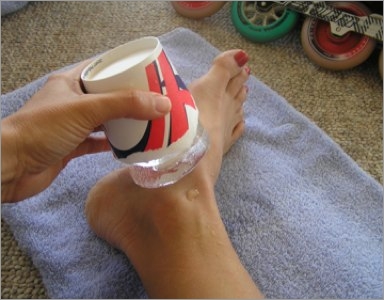Isn’t it ironic that when we get an injury or strain we typically know what caused it or what it is, but yet, one of the simplest parts, the treatment, it done wrong? Today, we are going to go on a journey from start to finish of proper icing techniques for injuries. Lately, I have been suffering from a problem with my calf and knee. At first, I thought that if I just ignored it, it would lessen. However, this was not the case. In fact, the opposite happened. I began having problems running because my knee felt as though it was going to go out. Because of this, I was forced to take a week off. I then had to go to the trainer, who told me how they wanted me to ice, which is what I am finding to be the proper way.
First, know where the injury is coming from. Then, immediately after you return apply the ice. One thing that I did learn was that ice packs, such as those you buy in the store, can be used but they are dangerous. Now, you may be wondering how can an ice pack be dangerous, but not ice? I was wondering the same thing and found my answer. An ice pack can reach very low temperatures which can cause additional damage. Also, these cannot be placed directly on the skin. The best icing tool is a bag of frozen peas or corn because it will conform to the shape of your leg. However, ice cubes will work and are less dangerous than ice packs. Then, place ice on the affected area. Leave the ice on for 10 to 20 minutes but no longer than 20 as this could cause damage to the muscles. Finally, take the ice off the area and do not exercise immediately because your muscles are stiff and injury prone. After an hour has passed, you can add ice and repeat these steps up to five times a day.
Now, suppose that just putting ice on the injury isn’t enough for you. Suppose you want a massage while icing the area. There is an easy and very inexpensive way to do this at home. First, fill a Styrofoam cup and place in the freezer. Then, once it is frozen, tear back part of the cup. Finally, hold the bottom of the cup and massage with the ice rubbing on the affected area.

I personally have never used the second icing method, though I know people who have. One member of my cross country team, who placed fifth in the state, has used it before. “It massaged my muscles and made me feel relaxed and run faster,” says Marissa Long. Personally, I use the first method, though I was very surprised to know the damage that ice packs could do. This makes me want to change my icing method. Also, I ice for around a half hour. I did not know the damage it could do so now I have changed my ways.
Good luck with the icing and keep running!More info:

No comments:
Post a Comment